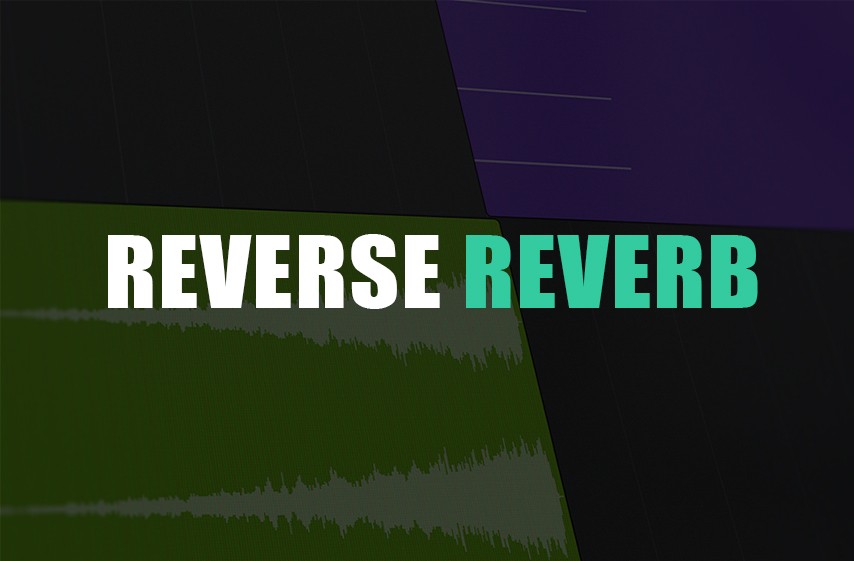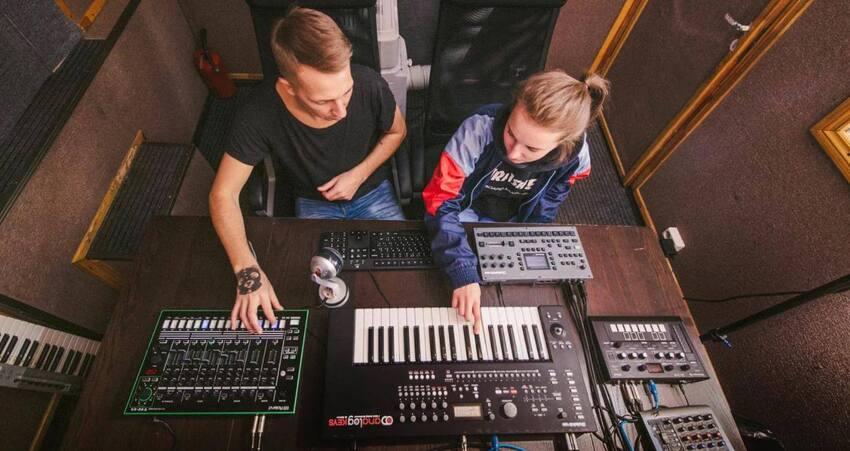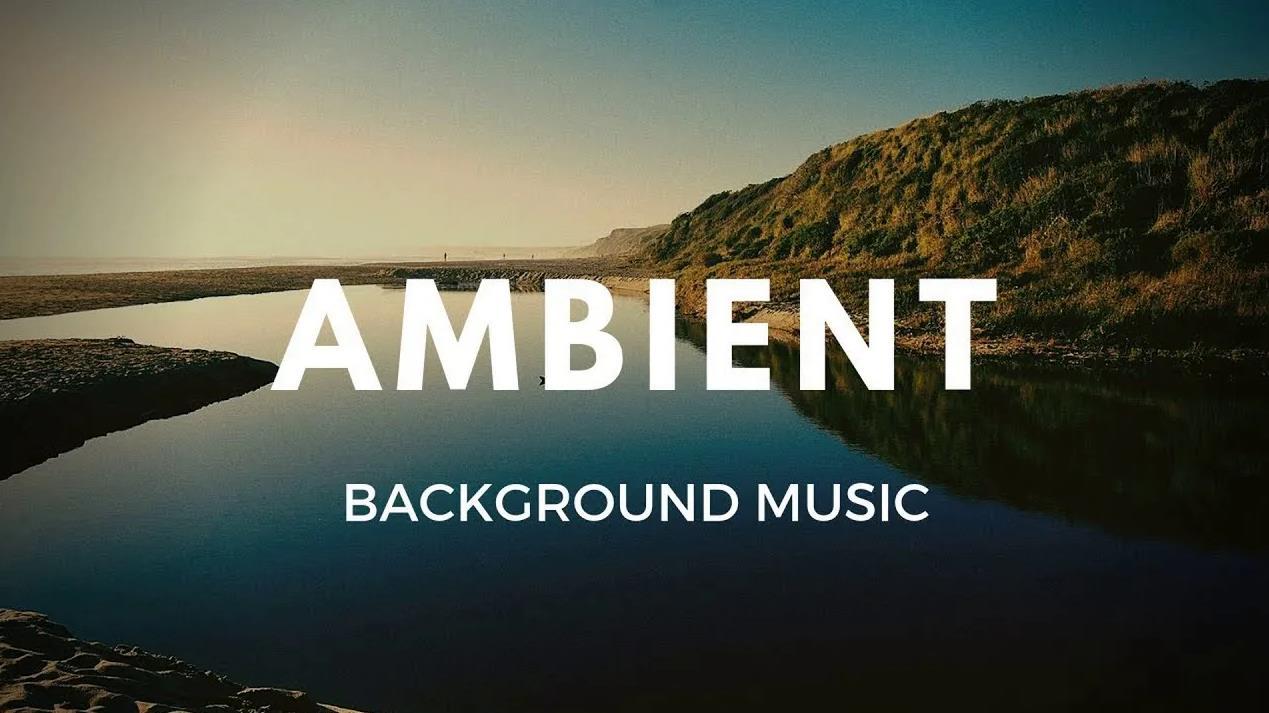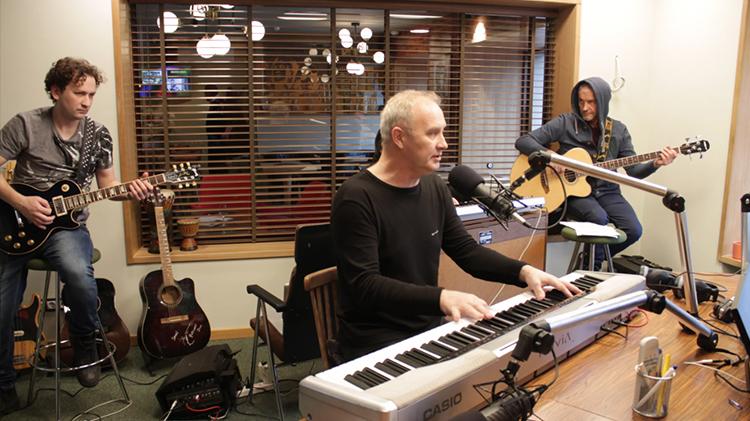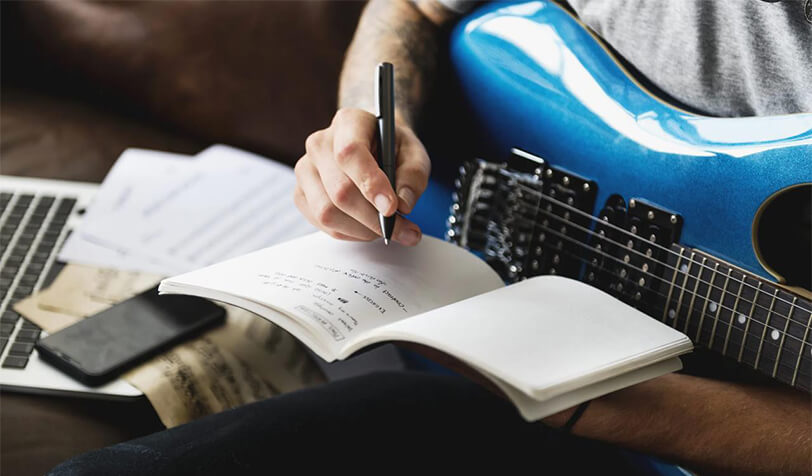What are tabs guitar

The online DAW Amped Studio allows you to both record live guitar and work with various guitar VST instruments. To fully work with sound to process the resulting recordings, both in audio and MIDI form, there is all the necessary software, primarily various effects: delays, reverbs, distortions, equalizers, amplifiers, etc. However, for working with When recording a guitar, it will be useful to understand guitar tablature at least at a basic level, as this greatly simplifies and speeds up the process itself.
Let’s dive into the world of guitar tablatures, study their pros and cons, consider various types, and even try to bring back a lost art – the art of competently creating tablatures. We will also try to create a format that can convey all the musical information as accurately as sheet music.
When a guitarist, whether a self-taught beginner or an experienced musician, decides to figure out how to play instrumental versions of his favorite compositions, he begins to realize that it is necessary not only to master complex fingerpicking and unusual chords. It gradually becomes clear that playing in this style requires knowledge of notation.
Tablature is a system of notating music for the guitar, where the strings are represented by horizontal lines and numbers indicate which notes to play. Tablatures are a great alternative to sheet music and allow guitarists to read music even without any music reading skills.
Tablatures have their pros and cons. Among the main advantages is accessibility. Even those who are not familiar with musical notation can easily master this form of music notation and start playing the guitar. Tablatures can also convey the features of guitar playing, including bends, slides and other techniques.
However, it should be remembered that tablature does not always accurately convey the rhythmic structure of the composition and does not always include details that can be found in musical notation.
Regardless, tablature remains an essential tool for guitarists of all levels. They help you master new compositions and improve your guitar playing skills. The world of guitar tablatures offers a fascinating journey, and they can become reliable companions in the world of music.
Tablature Basics
Tablature is a graphical representation of music in the form of a visual diagram that helps the guitarist determine the necessary strings, frets and the sequence of their sounds, taking into account the rhythm.
Guitar tablatures typically use 6 horizontal lines. The top line represents the first string of the guitar, while the bottom line represents the sixth string.
The numbers placed on the lines indicate which fret the string should be plucked at. The number “0” means that the string should be played open, without pressing the fret.
Often tablature lines run parallel to and are placed underneath the musical notation. In this case, the top row contains the sheet music, while the bottom row provides a graphical representation of the same music, serving as a “transcript” for those unfamiliar with the sheet music.
Guitar tablatures provide a convenient and intuitive way to convey musical information to guitarists, making them a valuable resource for learning and playing popular compositions.

The history of tablature
If modern notation began to take shape in the 17th century, then music intended for plucked string instruments, in the period from the 15th to the 17th centuries, was more often recorded using tablature.

It is interesting that tablature in different countries had its own designation features. For example, in Spain and France, tablatures used the same notation system as today: the strings were depicted as the musician himself saw them, with the thickest string located at the bottom of the tablature stand, closer to the ceiling, and the thinnest string at the top, closer to the floor .
In Italy, on the contrary, an alternative system was used: the strings were designated as the viewer saw them from the outside. That is, the thinnest string was at the bottom of the tablature, closer to the floor, and the thickest was at the top, closer to the ceiling.
These differences in string notation in historical tablatures add an interesting dimension to the history of musical notation and demonstrate the variety of methods of notation of music at different stages of the development of musical culture.
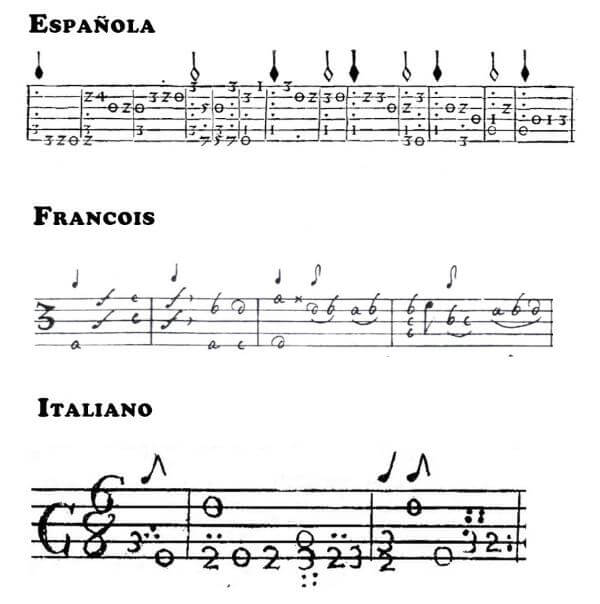
With German tablatures you can experience considerable difficulty at first glance: they seem to be some kind of mysterious symbols, and it is immediately unclear what they are and how to decipher them.

However, over time, musical notation began to penetrate even music performed on instruments for which tablature was the usual notation language. Gradually, notes replaced tablature notations. By the end of the 17th century, the notation had become very convenient and universal. She was able to provide a single world (primarily European) musical language, understandable to musicians of a wide variety of instruments – be it a lutenist, a harpsichordist/pianist, a violinist or a vocalist.However, until the 17th century the situation was different. Thus, music for lute, viol, and mandolin of the 15th-16th centuries was recorded in tablature.
In recent decades, especially at the end of the 20th and beginning of the 21st centuries, tablature has become relevant again. It is often used in combination with a note string and acts as a kind of “translator” of notes, providing simplified but sufficient information about where and how to play each individual note – on what strings and in what frets.
Types of tablature
Nowadays you can find different types of tablature on the Internet. Let’s look at them, simultaneously identifying the pros and cons of each variety.
Standard format – sheet music/tabs
There are two varieties here:
1. Notes have durations, tabs do not.

Some types of tablature require extra effort to understand and reproduce the rhythm because there is no information about the duration of the notes. This means that when reading such tablature you have to periodically switch to the staff, which can be somewhat tedious. Moreover, it takes away precious time and energy that could be spent on more comfortable and high-quality music performance.
Therefore, the second version of tablature, where the rhythm and duration of notes are more clearly presented, may be more preferable.
2. There are durations in both notes and tabs.
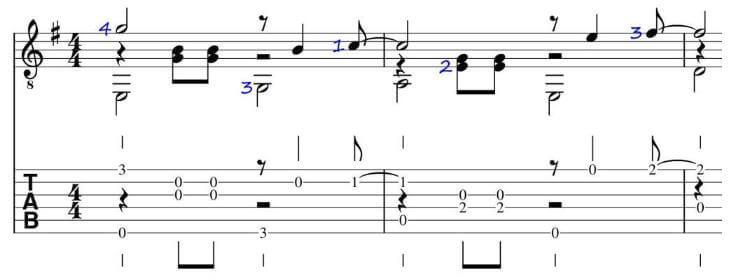
For guitarists who do not have knowledge of musical notation and rely solely on tablature, the presence of rhythm information in tabs turns out to be extremely convenient. In such variants of tablature, there is no need to refer to the musical note line to determine the duration of the notes, which significantly saves the musician’s time and effort.
The only limitation in such tablatures is the lack of fingerings – information about which fret and which string specific notes should be played on. For this purpose, you will still have to refer to the music line, if it is provided in the set.
The importance of rhythm
Rhythm is an integral part of music that beginner guitarists sometimes don’t pay enough attention to. Experienced musicians immediately pay attention to the rhythmicity or lack thereof in the playing of their novice colleagues.
Probably, most beginning guitarists limit themselves to studying tablature. This explains why most modern guitar bloggers, when presenting the arrangement of a composition, show only tablature, without notes. Tablatures often lack information about note durations, and this represents another type of tab.
The importance of rhythm
Rhythm is an integral part of music that beginner guitarists sometimes don’t pay enough attention to. Experienced musicians immediately pay attention to the rhythmicity or lack thereof in the playing of their novice colleagues.Probably, most beginning guitarists limit themselves to studying tablature. This explains why most modern guitar bloggers, when presenting the arrangement of a composition, show only tablature, without notes. Tablatures often lack information about note durations, and this represents another type of tab.
Tabs only (without musical notes) without durations
The guitarist is expected to play any melody by ear. There is no need to talk about any rhythm structure.
Many people have seen approximately the same unscientific method of designing tablature on various sites with chords.
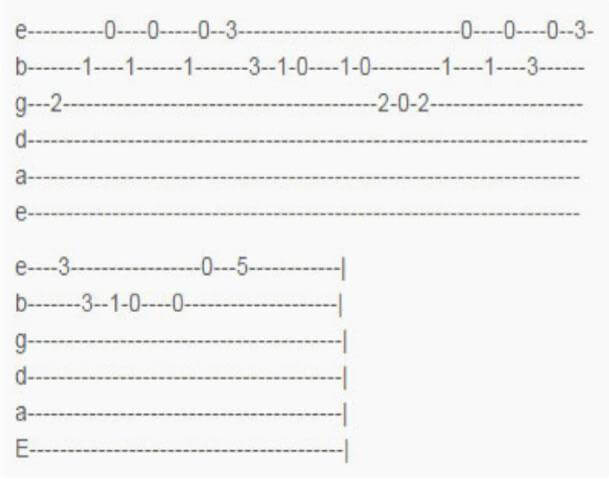
But this is an unprofessional method and approach; such a recording is very undesirable.
Only tabs (without a musical line), but with durations
There may be two options:
- when all voices (melody, bass, accompaniment) are not separated – everything is recorded under one style;
- when the voices are separated – the melody is recorded with the stem up, and the bass and accompaniment – with the stem down.
Tabs only: with durations, but with undivided voices
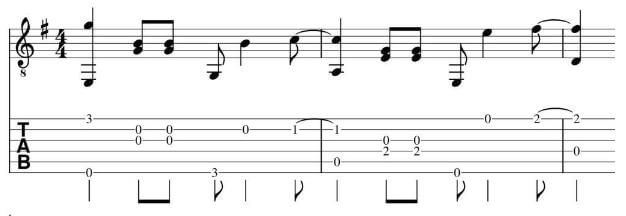
This form of recording music does not always make it possible to clearly determine which part is the melody and which is the accompaniment. However, it has its advantages. When a musical composition is divided into individual voices (high, low, and possibly middle), the rhythm may be more difficult to recognize. While in the case when all elements of music are recorded in the same style and are not divided into voices, the rhythm becomes more understandable. This can be considered one of the advantages of such a recording.
Only tabs, with durations and divided voices

Here it is, the crown and pinnacle of tablature evolution! (Just kidding!) This is just a competent recording, nothing special.
The voices are separated, clearly visible and each of them can be played separately.
Identification of voices
Now let’s discuss the issue of voices, which plays an important role, since many musicians, playing less rhythmically, may feel a lack of knowledge in the field of musical rhythm. Therefore, it is paramount to fill this knowledge gap.
Usually the voices are divided into two or three. Each vote can be tracked and counted independently. For example, in a 4/4 time measure, each voice would have four beats.
1. Two voices
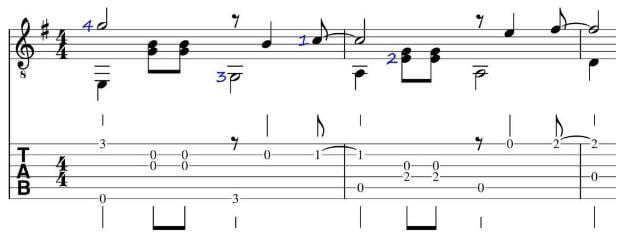
- upper voice – melody;
- lower voice – it combines bass notes and accompaniment notes.
2. Three voices

For clarity, we have designated each voice in different colors:
- upper voice – melody (calm up, color red);
- middle voice – accompaniment (calm down, color blue);
- lower voice – bass (calm down, color green).
But usually the notes are just black and white. And in this case, you need to understand how many voices there are without the “color differentiation of the pants” notes.
A three-voice musical recording, including melody, bass, and accompaniment, provides more complete and accurate information than a two-voice recording (consisting of melody, bass, and accompaniment). However, at first glance (especially for beginners), three-voice recording may seem more complex and difficult to understand, since it requires a more accurate calculation of the overall rhythm.
Therefore, in pop music, two-voice recordings are more often preferred, since their perception is considered easier. Sheet music or tablature is usually presented in black and white, but fingerings can be highlighted with a special color other than black, such as blue.
It looks like this:
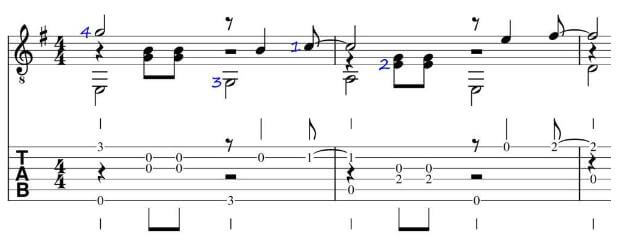
Let’s return to the types of tablature. Typically, tablatures do not indicate fingerings. If tablatures come along with musical notations, then the notes may indicate the fingering. In this case, to understand the fingering by reading only the tablature, you have to constantly switch between tabs and notes to find out where to press the strings and keep the rhythm.
But is it possible to write down all the necessary information (rhythm and fingering) exclusively in tablature, completely abandoning musical notation? Of course, this is completely doable. We can try to write the rhythm correctly using several voices in the tablature, such as melody, accompaniment and bass. To avoid confusion with numbers (since left-hand fingerings are also indicated by numbers, just like frets in tablature), we can indicate fingerings using a different color, such as blue for the left hand and green for the right, and use a different font.
We can also place the fingerings primarily above the voices in the tablature to avoid them crossing and mixing.
Here’s what happened:

This is a really interesting and unusual solution. These tablatures contain almost everything that can be found in musical notations:
- Rhythm;
- Various voices, including melody, bass and accompaniment;
- Fingering covering not only the left, but also the right hand.
However, it is important to note that such tablatures do not contain the actual notes. This means that by playing only from tablature, the musician will not have a full understanding of what specific notes sound in the melody. This can be an important aspect in professional music performance, especially if the musician needs to interact with other instruments or musicians using notation.
Thus, these tablatures can be useful for guitarists, but for a more complete and professional understanding of the music, it is sometimes necessary to turn to sheet music.
Knowledge of notes even for those who play only by tabs
Many guitarists who are passionate tablature players but have no experience with sheet music sometimes underestimate the value of musical notation. Sheet music is a universal musical language that opens up endless possibilities for the musician. Understanding the basics of notation gives music depth and facilitates interaction between musicians of different styles and professional levels.
Knowing sheet music involves two aspects. The first is the ability to read music on a stave, which is mandatory for professional musicians and recommended for amateurs. The second aspect is the ability to find a match between notes on your instrument, for example, a guitar, knowing which fret and string the desired note is on. This skill is also essential for musicians of all levels.
Professionals always think musically through sheet music, rather than using digital tablature, if they strive for a high level of skill. In practice, there are often situations when a guitarist-arranger works with sheet music editors and pays the main attention to the notes, leaving tablature in the background. In such cases, programs may automatically select fingerings that are sometimes incorrect. Without knowledge of musical notation, a musician may not always recognize an error and correct it.
This highlights the importance of being able to read and interpret music. Studying notes (at least on the fretboard of an instrument) is an integral part of music education that will enrich you as a musician, allow you to recognize mistakes and improve your music performance, and provide a deeper musical understanding.



